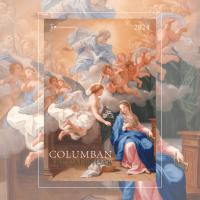
Q: Can you describe the area where you work in Peru?
A: Our parish of Yanaoca in the Prelature of Sicuani is about a two and a half hour drive from Cuzco, the ancient capital of the Incas. I work with another Columban priest, Fr Paul Prendergast, from New Zealand. The altitude is about 3,950 metres. In general, the landscape is barren with few trees and with barely enough vegetation for sheep, llamas and some cattle.
Q: How about the climate?
A: There are just two seasons: the rainy season from November to April and the dry season from May to October. Most farm work is done in the rainy season. Crops are sown and there is more grass for animals. Lightning is particularly dangerous in the rainy season and every year it kills some individuals and even family groups.
Q: What language do you use?
A: Both Spanish and Quechua. About 40% of the people who live in the mountains use Quechua, the ancient language of the Incas. The younger people use Spanish more now as they are aware of being looked-down on if they use Quechua.
Q: So discrimination is a fact of life for Andean people who speak Quechua?
A: Yes, and this often causes them to have low self-esteem. For example, sometimes when they have to go to a government office they get poor attention because of language difficulties or illiteracy.
Q: How about the situation of women in the mountain regions?
A: Normally the women spend their time in the house, looking after the children and working on the farm with very little outside contact. Most of the women are illiterate and don’t understand Spanish, the national language. So they are very dependent. However, little by little some changes are taking place.
Q: Is religion an important element in the life of the people?
A: Long before the Spaniards came in 1531 and later, Christianity, the people had what we might call a natural religion. By nature they are religious people who are very aware of their relationship with their environment and especially with Pacha Mama or mother earth. When they became Christians many of these elements remained as part of their belief system.
Q: How do you as a Catholic missionary relate to what was there before?
A: First of all we, as missionaries, have to be very aware of the values they already have. God ‘was there’ long before we came. Their thinking is very concrete; they believe in what they can see. The earth produces food so respect for earth is what should be at the centre of religious practice. The idea of a God or of a creator beyond earth can appear to be a very abstract idea. They can, for example, relate more easily to the saints, people they can ‘see.’ The annual parish fiestas and processions with the statues ensure protection for the village.
Q: What are your responsibilities at the moment?
A: Theoretically at least, I have been responsible for what were originally six parishes; probably about 50,000 Catholics. In the parish of Yanaoca where I work at present there are two Columban sisters, five Peruvian sisters and four priests – two Columbans and two associate priests.
Q: How do you see your own role as parish priest of such a large area?
A: A first priority is to take care of the sacramental life of the communities. A second priority is concern for the physical and educational needs. For example about 70% of people in the parish cannot read so we offer educational programmes. We have opened a Casa del Niño – a centre for education of children and youth. We also get volunteer doctors and dentists to come from the city to offer their service. A third priority is to help to offer a spiritual formation leading to a more educated faith.
Q: In general, is communication difficult in your area?
A: Yes, in many ways. For instance we don’t have internet, email etc. Often organizations still depend on two-way radio. The diocesan radio is an important instrument for us; we also have a small parish radio studio now. This is invaluable in an area where many people cannot read.
Q: You are preparing to return to Peru for another term - What would you like to do next time?
A: I would like to do more for the children and young people. Many of them just survive in the mountains with little education and have no option but poverty on the subsistence farm. At present we are teaching young people some skills. We have workshops in mechanics and computer training. We hope to generate a greater self-esteem and help them take pride in their own language, culture and history so that their lives and opportunities may be better than in times past.
Columban Fr Alo Connaughton is a former editor of The Far East magazine in Ireland. Ordained in 1969, he is now involved in the formation of seminarians in Thailand and China.
Related links
- Read more from The Far East, June 2018

